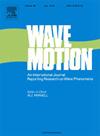Sloshing characteristics of viscoelastic liquids in a rectangular container with a floating flexible plate
IF 2.1
3区 物理与天体物理
Q2 ACOUSTICS
引用次数: 0
Abstract
The study examines the sloshing behavior of two superposed viscoelastic fluid layers governed by Walter’s liquid ‘B” model within a rectangular tank, subjected to horizontal vibrations. Our investigation is extending to take into account the influence of a flexible plate floating on the top fluid layer, where a modified membrane equation is used to model the stress balance on the surface. Additionally, an insoluble surfactant exists at the liquid–liquid interface within the flow system. The problem’s mathematical model is linked with the linearized Navier–Stokes equation for viscoelastic fluids, along with boundary conditions, which are solved using Laplace transform. Durbin’s numerical inverse Laplace transform scheme is used to numerically calculate solutions of the governing equations in the time domain. Graphical representations of the numerical results are included to investigate the free surface profiles, sloshing forces and moments skeletons and evolution of surface concentration under horizontal excitations, examining their behavior in relation to uniform thickness and structural rigidity of the floating elastic plate; Marangoni number and the relaxation times coefficients of the fluids. The results showed that both the thickness and structural rigidity of the floating elastic enhances the wave stability of both free surfaces of liquids, and it also causes a significant decrease in the forces acting on the walls of the container, which constitutes a safety factor to maintain the integrity of the container. On the other hand, increasing the viscoelastic parameters stimulates the sloshing waves and increases the compressive forces on the walls of the container.
弹性浮板矩形容器中粘弹性液体的晃动特性
该研究考察了受水平振动影响的矩形槽内由Walter液体“B”模型控制的两个叠加粘弹性流体层的晃动行为。我们的研究扩展到考虑浮动在顶部流体层上的柔性板的影响,其中使用改进的膜方程来模拟表面的应力平衡。此外,在流动系统的液-液界面处存在一种不溶性表面活性剂。该问题的数学模型与粘弹性流体的线性化Navier-Stokes方程联系在一起,并带有边界条件,用拉普拉斯变换求解。采用Durbin的数值拉普拉斯逆变换格式对控制方程的时域解进行了数值计算。采用数值结果的图形表示,研究了水平激励下的自由表面轮廓、晃动力和力矩骨架以及表面浓度的演变,并研究了它们与浮动弹性板均匀厚度和结构刚度的关系;马兰戈尼数和流体的松弛时间系数。结果表明,浮弹的厚度和结构刚度都增强了液体自由表面的波动稳定性,同时也使作用在容器壁上的力显著减小,构成了保持容器完整性的安全系数。另一方面,增加粘弹性参数刺激了晃动波,增加了容器壁面上的压缩力。
本文章由计算机程序翻译,如有差异,请以英文原文为准。
求助全文
约1分钟内获得全文
求助全文
来源期刊

Wave Motion
物理-力学
CiteScore
4.10
自引率
8.30%
发文量
118
审稿时长
3 months
期刊介绍:
Wave Motion is devoted to the cross fertilization of ideas, and to stimulating interaction between workers in various research areas in which wave propagation phenomena play a dominant role. The description and analysis of wave propagation phenomena provides a unifying thread connecting diverse areas of engineering and the physical sciences such as acoustics, optics, geophysics, seismology, electromagnetic theory, solid and fluid mechanics.
The journal publishes papers on analytical, numerical and experimental methods. Papers that address fundamentally new topics in wave phenomena or develop wave propagation methods for solving direct and inverse problems are of interest to the journal.
 求助内容:
求助内容: 应助结果提醒方式:
应助结果提醒方式:


